Layer Thickness Effects on Residual Stress, Microstructure, and Tensile Properties of Cu18150/Al1060/Cu18150 Multilayered Composites: An Integrated EBSD-KAM Approach
Abstract
1. Introduction
2. Materials and Methods
2.1. Material Fabrication
- Being below the solidus temperatures of both Cu18150 (1083 °C) and Al1060 (660 °C) to prevent partial melting.
- Providing sufficient thermal activation for diffusion bonding (Q ≈ 0.4–0.6 Tm),
- Minimizing oxide formation (oxidation rates increase exponentially above 300 °C),
2.2. EBSD Analysis
2.3. Mechanical Properties
3. Results and Discussion
3.1. Microstructural Evolution with Layer Thickness
3.1.1. Grain Structure Characteristics
3.1.2. Phase Distribution and Intermetallic Formation
3.2. Texture Development
3.3. Residual Stress and Dislocation Density Analysis
3.3.1. KAM Distribution Patterns
3.3.2. Misorientation Analysis
3.3.3. Residual Stress Gradients
3.4. Mechanical Properties
3.5. Strengthening Mechanisms
- Hall-Petch strengthening: The refined grain structure in thinner samples contributes significantly to their enhanced strength. Using the Hall-Petch relationship (σy = σ0 + kd−1/2), where d is grain size, we observe excellent correlation between measured grain sizes and yield strengths;
- Dislocation strengthening: The KAM and misorientation data directly correlate with measured strength levels. Higher average KAM values in intermediate thicknesses (1.6–2.4 mm) correspond to greater dislocation densities and thus higher strength;
- Interface constraint effects: Thinner layers experience greater constraint from adjacent layers, inhibiting dislocation motion and promoting strain hardening. This effect diminishes with increasing layer thickness; and
- Residual stress contributions: The compressive residual stresses near interfaces in thinner samples provide additional strengthening by opposing applied tensile stresses.
4. Conclusions
- Layer thickness significantly influences microstructural evolution in Cu18150/Al1060/Cu18150 composites, with thinner layers (0.9–1.6 mm) exhibiting refined grains (1.23–1.73 µm), stronger textures (PF intensities to 6.15), and higher dislocation densities (KAM to 0.48°) compared to thicker counterparts.
- Residual stress analysis reveals pronounced interface stress gradients in intermediate thicknesses (1.6–2.4 mm), contributing to their enhanced mechanical performance through strain hardening mechanisms.
- Tensile properties show clear thickness dependence, with the 0.9 mm sample achieving maximum strength (351 MPa UTS) through grain refinement and interface constraints, while the 4 mm variant offers superior ductility (30% elongation) due to reduced constraints and more homogeneous deformation.
- The 2.4 mm thickness emerges as the optimal configuration, balancing strength (317 MPa) and ductility (26% elongation) through a combination of moderate grain refinement, strong texture development, and well-distributed residual stresses.
- The study establishes comprehensive structure-property relationships in multilayer composites, providing a foundation for tailored material design based on application-specific requirements for strength, ductility, and residual stress distribution.
Author Contributions
Funding
Informed Consent Statement
Data Availability Statement
Conflicts of Interest
References
- Wiener, J.; Kaineder, H.; Kolednik, O.; Arbeiter, F. Optimization of Mechanical Properties and Damage Tolerance in Polymer-Mineral Multilayer Composites. Materials 2021, 14, 725. [Google Scholar] [CrossRef]
- Wu, Y.; Ye, H.; Zheng, G.; Mei, C.; Cai, L.; van Le, Q.; Xia, C. Multilayered Nanocomposites Prepared Through Quadruple-Layering Approach towards Enhanced Mechanical Performance. Molecules 2022, 27, 4852. [Google Scholar] [CrossRef]
- Ebrahimi, M.; Shaeri, M.H.; Gode, C.; Armoon, H.; Shamsborhan, M. The Synergistic Effect of Dilute Alloying and Nanostructuring of Copper on the Improvement of Mechanical and Tribological Response. Compos. Part B Eng. 2019, 164, 508–516. [Google Scholar] [CrossRef]
- Jiang, S.; Peng, R.L.; He, Z.F.; Cui, L.Q.; Hegedüs, Z.; Lienert, U.; Jia, N. Mechanical Behavior Anisotropy of Multilayered Metallic Composites Revealed by In-Situ Synchrotron X-Ray Diffraction: Example of Ti/Nb Laminates Processed by Accumulative Roll Bonding. Acta Mater. 2025, 287, 120815. [Google Scholar] [CrossRef]
- Zhao, Y. Co-Precipitated Ni/Mn Shell Coated Nano Cu-Rich Core Structure: A Phase-Field Study. J. Mater. Res. Technol. 2022, 21, 546–560. [Google Scholar] [CrossRef]
- Cui, M. Physicochemical State Classification of Heat-Treated TC4 Samples Based on Laser-Induced Breakdown Spectroscopy (LIBS). At. Spectrosc. 2024, 45, 324–335. [Google Scholar] [CrossRef]
- Liu, Y.; Zhu, L.; Ma, G.; Lu, Y.; Wei, A.; Yang, C.; Huang, Y.; Liu, M.; Wang, H. Tribocorrosion Behaviours and Mechanisms of Inconel 625–Nano/Micro Al2O3 Composite Coatings Prepared by Plasma Enhanced High-Velocity Arc Spraying. Corros. Sci. 2025, 256, 113221. [Google Scholar] [CrossRef]
- Zheng, H.; Zhang, R.; Xu, Q.; Kong, X.; Sun, W.; Fu, Y.; Wu, M.; Liu, K. Fabrication of Cu/Al/Cu Laminated Composites Reinforced with Graphene by Hot Pressing and Evaluation of Their Electrical Conductivity. Materials 2023, 16, 622. [Google Scholar] [CrossRef]
- Ebrahimi, M.; Luo, B.; Wang, Q.; Attarilar, S. High-Performance Nanoscale Metallic Multilayer Composites: Techniques, Mechanical Properties and Applications. Materials 2024, 17, 2124. [Google Scholar] [CrossRef]
- Ebrahimi, M.; Liu, G.; Li, C.; Wang, Q.; Jiang, H.; Ding, W.; Su, F. Experimental and Numerical Analysis of Cu/Al8011/Al1060 Trilayered Composite: A Comprehensive Study. J. Mater. Res. Technol. 2020, 9, 14695–14707. [Google Scholar] [CrossRef]
- Huang, M.; Xu, C.; Fan, G.; Maawad, E.; Gan, W.; Geng, L.; Lin, F.; Tang, G.; Wu, H.; Du, Y.; et al. Role of Layered Structure in Ductility Improvement of Layered Ti-Al Metal Composite. Acta Mater. 2018, 153, 235–249. [Google Scholar] [CrossRef]
- Zhang, S.; Wang, F.; Huang, P. Enhanced Hall-Petch Strengthening in Graphene/Cu Nanocomposites. J. Mater. Sci. Technol. 2021, 87, 176–183. [Google Scholar] [CrossRef]
- Ebrahimi, M.; Liu, G.; Li, C.; Wang, Q.; Jiang, H.; Ding, W.; Su, F.; Shang, Z. Characteristic Investigation of Trilayered Cu/Al8011/Al1060 Composite: Interface Morphology, Microstructure, and in-Situ Tensile Deformation. Prog. Nat. Sci. Mater. Int. 2021, 31, 679–687. [Google Scholar] [CrossRef]
- Rydz, D.; Stradomski, G.; Szarek, A.; Kubik, K.; Kordas, P. The Analysis of Pressed Cups Producing Possibilities from Rolled Bimetallic Al-1050 + Cu-M1E Sheets. Materials 2020, 13, 2413. [Google Scholar] [CrossRef]
- Wąsek, S.; Mróz, S.; Stradomski, G.; Laber, K.B. The Analysis of Al-Cu Bimetallic Bars Bond Layers Joined by the Explosive Method. Solid State Phenom. 2013, 199, 508–513. [Google Scholar] [CrossRef]
- Rydz, D.; Krakowiak, M.; Bajor, T.; Stradomski, G. The Analysis of the Impact Relative Rolling Reduction at the Area Connector Bimetallic Plate after the Rolling Process. Solid State Phenom. 2013, 199, 514–517. [Google Scholar] [CrossRef]
- Rydz, D.; Skoblik, R. Numerical Modelling of Asymmetric Double-Layer Al-Cu Plate Rolling Process. Adv. Mater. Sci. 2006, 6, 29–34. [Google Scholar]
- Rydz, D.; Stradomski, G.; Pałęga, M.; Salwin, M.; Opydo, M.; Szarek, A.; Fik, J.; Chmielewski, T. Analysis of Plastic Forming During Rolling of Al1050-AZ31-Al1050 Layered Composites for Transport Purposes. Adv. Sci. Technol. Res. J. 2024, 18, 234–244. [Google Scholar] [CrossRef] [PubMed]
- Rydz, D.; Dyja, H.; Berski, S. The Prediction of Curvature of Bimetallic Plate Al-Cu During Asymmetrical Cold Rolling. Metalurgija 2003, 42, 261–264. [Google Scholar]
- Cai, H.; Wang, Q.; Zhang, N.; Ebrahimi, M.; Zhao, Y.; Liu, L.; Guo, F. Shear Behavior of Cu/Al/Cu Trilayered Composites Prepared by High-Temperature Oxygen-Free Rolling. J. Alloys Compd. 2024, 1004, 175857. [Google Scholar] [CrossRef]
- Lei, C.; Wang, Q.; Ebrahimi, M.; Li, D.; Tang, H.; Zhang, N.; Cai, H. Hot Deformation Behavior and Processing Maps of an As-Cast Al-5Mg-3Zn-1Cu (wt%) Alloy. Materials 2023, 16, 4093. [Google Scholar] [CrossRef] [PubMed]
- Liu, Y.; Su, J.; He, D.; Hao, P.; Liu, Y.; Wang, Z.; Wang, T. Analytical Model for Corrugated Rolling of Composite Plates Considering the Shear Effect. J. Manuf. Process. 2025, 134, 1069–1081. [Google Scholar] [CrossRef]
- Zhang, X.; Wang, D.; Nagaumi, H.; Wu, Z.; Zhang, M.; Wang, R.; Zou, J.; Chen, H.; Wang, P.; Zhou, P. Unveiling the Growth Mechanism of Fe-Containing Intermetallics in Al–Si Alloy in the Perspective of Surface Stability and Atom Adsorption. J. Mater. Res. Technol. 2025, 35, 2458–2470. [Google Scholar] [CrossRef]
- Dong, H.; Zhu, D.; Yang, T.Y.; Xia, F.; Chen, Q.; Guo, Y.C. Interface-Dominated Microstructure Development and Mechanical and Electrical Properties of Al/Cu Multilayered Composites Prepared via Multicomponent Accumula-tive Roll Bonding. J. Alloys Compd. 2025, 1017, 179149. [Google Scholar] [CrossRef]
- Jia, L.; Hu, C.; Zhang, M.; Dong, H.; Zhu, X.; Cheng, L.; Xue, H.; Zhao, J.; Wu, K. Interplay Between H Atoms and Characteristic Microstructure Features in 2100 MPa Grade Full Pearlite Steel Wire for Bridge Cable. Int. J. Hydrogen Energy 2025, 172, 151226. [Google Scholar] [CrossRef]
- Shao, L.; Li, W.; Lu, Q.; Xue, N.; Chen, Y.; Wu, Y.; Liu, C.; Liu, Y.; Sajjad, K.; Shi, Q.; et al. Bonding Mechanism in Cu Coating Deposited on Al Alloy Substrate: Combining Molecular Dynamics Simulation and Experiment. Mater. Sci. Eng. A 2025, 942, 148703. [Google Scholar] [CrossRef]
- Wang, C.; Zhang, Z.; Jing, X.; Yang, Z.; Xu, W. Optimization of Multistage Femtosecond Laser Drilling Process Using Machine Learning Coupled with Molecular Dynamics. Opt. Laser Technol. 2022, 156, 108442. [Google Scholar] [CrossRef]
- Zhang, Z.; Liu, S.; Zhang, Y.; Wang, C.; Zhang, S.; Yang, Z.; Xu, W. Optimization of Low-Power Femtosecond Laser Trepan Drilling by Machine Learning and a High-Throughput Multi-Objective Genetic Algorithm. Opt. Laser Technol. 2022, 148, 107688. [Google Scholar] [CrossRef]
- Shen, Z.; Dong, R.; Li, J.; Su, Y.; Long, X. Determination of Gradient Residual Stress for Elastoplastic Materials by Nanoindentation. J. Manuf. Process. 2024, 109, 359–366. [Google Scholar] [CrossRef]
- Xu, H.; Wang, Y.; Liu, M.; Zhai, Y. Alternating Multilayered Ti3C2Tx/Co Sandwich with Co Frosting for Superior Electromagnetic Wave Absorption Performance and Infrared Stealth Ability. ACS Appl. Mater. Interfaces 2025, 17, 47679–47695. [Google Scholar] [CrossRef] [PubMed]
- Li, X.; Zhang, L.; Li, Y.; Zhao, Y.; Guo, Z.; Wang, H.; Liu, K.; Bai, P.; Liu, B.; Tang, H.; et al. Advances in Additive Manufacturing of Cemented Carbides: From Powder Production to Mechanical Properties and Future Challenges. Curr. Opin. Solid State Mater. Sci. 2025, 38, 101238. [Google Scholar] [CrossRef]
- Liu, S.; Li, Y.; Chen, P.; Li, W.; Gao, S.; Zhang, B.; Ye, F. Residual Stresses and Mechanical Properties of Si3N4/SiC Multilayered Composites with Different SiC Layers. Boletín Soc. Espa. Cerám. Vidr. 2017, 56, 147–154. [Google Scholar] [CrossRef]
- Gu, J.; Li, R.; Qiu, Y.; Yue, H.; Liu, B.; Gu, H. Microstructure, Mechanical Properties, and Residual Stress Distribution of AISI 316L Stainless Steel Part Fabricated by Laser Metal Deposition. Scanning 2020, 2020, 4831798. [Google Scholar] [CrossRef]
- Li, S.; Luo, C.; Liu, Z.; Zhao, J.; Han, J.; Wang, T. Interface Characteristics and Mechanical Behavior of Cu/Al Clad Plate Produced by the Corrugated Rolling Technique. J. Manuf. Process. 2020, 60, 75–85. [Google Scholar] [CrossRef]
- Shen, R.R.; Efsing, P. Overcoming the Drawbacks of Plastic Strain Estimation Based on KAM. Ultramicroscopy 2018, 184, 156–163. [Google Scholar] [CrossRef]
- Mao, F.; Guo, J.-L.; Liu, S.-H.; Zhang, L.-B.; Guo, A.-Z.; Chen, C.; Chen, Z.-N.; Li, J.-H.; Wang, T.-M.; Wei, S.-Z. Spheroidization Mechanism of Primary Silicon in Hypereutectic Al–Si Alloys with Eu Addition. Rare Met. 2025, 44, 7940–7955. [Google Scholar] [CrossRef]
- Xie, W.-T.; Song, D.-N.; Tang, W.-C.; Ma, J.-W.; Li, J.-H. Auxiliary Support Path Planning for Robot-Assisted Machining of Thin-Walled Parts with Non-Uniform Thickness and Closed Cross-Section Based on a Neutral Surface. J. Manuf. Process. 2025, 147, 16–28. [Google Scholar] [CrossRef]
- Fu, Y.; Yousefi Mehr, V.; Toroghinejad, M.R.; Chen, X.; Jie, J.; Zhu, S. Twinning and Stacking Fault-Induced Precipitation in an Aluminum Alloy. J. Mater. Res. Technol. 2025, 34, 2127–2132. [Google Scholar] [CrossRef]
- Shi, S.; Zhao, Y.; Lin, X.; Deng, H.; Zhao, L.; He, G.; Huang, W. Significance of α-Al Cellular Matrix in Tensile Behavior and Work-Hardening of Additive Manufactured AlSi10Mg Alloy. Virtual Phys. Prototyp. 2025, 20, e2449189. [Google Scholar] [CrossRef]
- Xu, X.; Hao, Y.; Dong, R.; Hou, H.; Zhao, Y. Effect of Undercooling on Microstructure Evolution of Cu Based Alloys. J. Alloys Compd. 2023, 935, 167998. [Google Scholar] [CrossRef]
- Tabatabaeian, A.; Ghasemi, A.R.; Shokrieh, M.M.; Marzbanrad, B.; Baraheni, M.; Fotouhi, M. Residual Stress in Engineering Materials: A Review. Adv. Eng. Mater. 2022, 24, 2100786. [Google Scholar] [CrossRef]
- Benedikt, B.; Lewis, M.; Rangaswamy, P.; Kumosa, M.; Predecki, P.; Kumosa, L.; Gentz, M. Residual Stress Analysis in Aged Graphite/PMR-15 Composites Using X-Ray Diffraction. Mater. Sci. Eng. A 2006, 421, 1–8. [Google Scholar] [CrossRef]
- Ebrahimi, M.; Zhao, Y.; Cai, H.; Attarilar, S.; Shang, Z.; Wang, Q. Interface Characterization of Cu18150/Al1060/Cu18150 Laminated Composite Produced by Combined Cast-Roll and Hot-Roll Technique. J. Mater. Res. Technol. 2025, 36, 7111–7124. [Google Scholar] [CrossRef]
- Kraner, J.; Cvahte, P.; Šuštarič, P.; Šuštar, T.; Donik, Č.; Paulin, I.; Kim, S.K.; Kim, K. Il Effects of Variated Final Temperature and Workpiece Thickness for Hot Rolling of Aluminum Alloy EN AW-8011. Metals 2023, 13, 1301. [Google Scholar] [CrossRef]
- Pu, J.; Chen, T.; Sun, Y.; Long, W.; Sun, H.; Chen, Y. Effect of Heat Treatment Temperature on the Microstructure and Properties of Titanium-Clad Steel Plate Prepared by Vacuum Hot Rolling. Coatings 2024, 14, 1096. [Google Scholar] [CrossRef]
- Beausir, B.; Fundenberger, J.-J. Analysis Tools for Electron and X-Ray Diffraction, ATEX—Software. Université de Lorraine-Metz. 2017. Available online: www.atex-software.eu (accessed on 29 June 2025).
- Li, X.; Lu, K. Refining Grains of Metals Through Plastic Deformation: Toward Grain Size Limits. Accounts Mater. Res. 2021, 2, 108–113. [Google Scholar] [CrossRef]
- Jia, H.; Guo, Z.; Wu, R.; Zhang, S. Grain Refinement of Mg-14Li Alloy by Sn Addition and Large Strain Rolling. Front. Mater. 2022, 9, 1050764. [Google Scholar] [CrossRef]
- Zhu, W.; Xing, S.; Wang, L.; Yang, Z.; Yu, W.; Yin, A.; Li, W.; Jiang, C.; Ji, V. Thermal Stability of Residual Stress, Microstructure, and Mechanical Property in Shot-Peened CNT/Al-Cu-Mg Composites. Coatings 2024, 14, 1571. [Google Scholar] [CrossRef]
- Xi, Y.; Bai, Y.; Gao, K.; Pang, X.; Yang, H.; Yan, L.; Volinsky, A.A. Residual Stress and Microstructure Effects on Mechanical, Tribological and Electrical Properties of TiN Coatings on 304 Stainless Steel. Ceram. Int. 2018, 44, 15851–15858. [Google Scholar] [CrossRef]
- Théodore, J.; Couturier, L.; Girault, B.; Cabeza, S.; Pirling, T.; Frapier, R.; Bazin, G.; Courant, B. Relationship Between Microstructure, and Residual Strain and Stress in Stainless Steels in-Situ Alloyed by Double-Wire Arc Additive Manufacturing (D-WAAM) Process. Materialia 2023, 30, 101850. [Google Scholar] [CrossRef]
- Shkatulyak, N. Effect of Stacking Fault Energy on the Mechanism of Texture Formation During Alternating Bending of FCC Metals and Alloys. Int. J. Nonferrous Metall. 2013, 2, 35–40. [Google Scholar] [CrossRef]
- Linda, A.; Tripathi, P.K.; Nagar, S.; Bhowmick, S. Effect of Pressure on Stacking Fault Energy and Deformation Behavior of Face-Centered Cubic Metals. Materialia 2022, 26, 101598. [Google Scholar] [CrossRef]
- Sathiaraj, G.D.; Kalsar, R.; Suwas, S.; Skrotzki, W. Effect of Stacking Fault Energy on Microstructure and Texture Evolution During the Rolling of Non-Equiatomic CrMnFeCoNi High-Entropy Alloys. Crystals 2020, 10, 607. [Google Scholar] [CrossRef]
- Qin, J.; Li, X.; Wang, D.; Zhou, C.; Hu, T.; Wang, J.; Yang, Y.; Hu, Y. Microstructure and Texture Evolution in Cold-Rolled and Annealed Oxygen-Free Copper Sheets. Materials 2024, 17, 2202. [Google Scholar] [CrossRef]
- Humphreys, F.J.; Hatherly, M. Recrystallization and Related Annealing Phenomena; Elsevier: Amsterdam, The Netherlands, 2004; ISBN 9780080441641. [Google Scholar]
- Carpenter, J.S.; McCabe, R.J.; Zheng, S.J.; Wynn, T.A.; Mara, N.A.; Beyerlein, I.J. Processing Parameter Influence on Texture and Microstructural Evolution in Cu-Nb Multilayer Composites Fabricated via Accumulative Roll Bonding. Metall. Mater. Trans. A 2014, 45, 2192–2208. [Google Scholar] [CrossRef]
- Schuh, C.A.; Nieh, T.G.; Iwasaki, H. The Effect of Solid Solution W Additions on the Mechanical Properties of Nanocrystalline Ni. Acta Mater. 2003, 51, 431–443. [Google Scholar] [CrossRef]
- Balokhonov, R.; Romanova, V.; Schwab, E.; Zemlianov, A.; Evtushenko, E. Computational Microstructure-Based Analysis Of Residual Stress Evolution in Metal-Matrix Composite Materials During Thermomechanical Loading. Facta Univ. Ser. Mech. Eng. 2021, 19, 241–252. [Google Scholar] [CrossRef]
- Ashby, M.F. The Deformation of Plastically Non-Homogeneous Materials. Philos. Mag. J. Theor. Exp. Appl. Phys. 1970, 21, 399–424. [Google Scholar] [CrossRef]
- Basinski, Z.S.; Basinski, S.J. Fundamental Aspects of Low Amplitude Cyclic Deformation in Face-Centred Cubic Crystals. Prog. Mater. Sci. 1992, 36, 89–148. [Google Scholar] [CrossRef]
- Withers, P.J.; Bhadeshia, H.K.D.H. Residual Stress. Part 1—Measurement Techniques. Mater. Sci. Technol. 2001, 17, 355–365. [Google Scholar] [CrossRef]
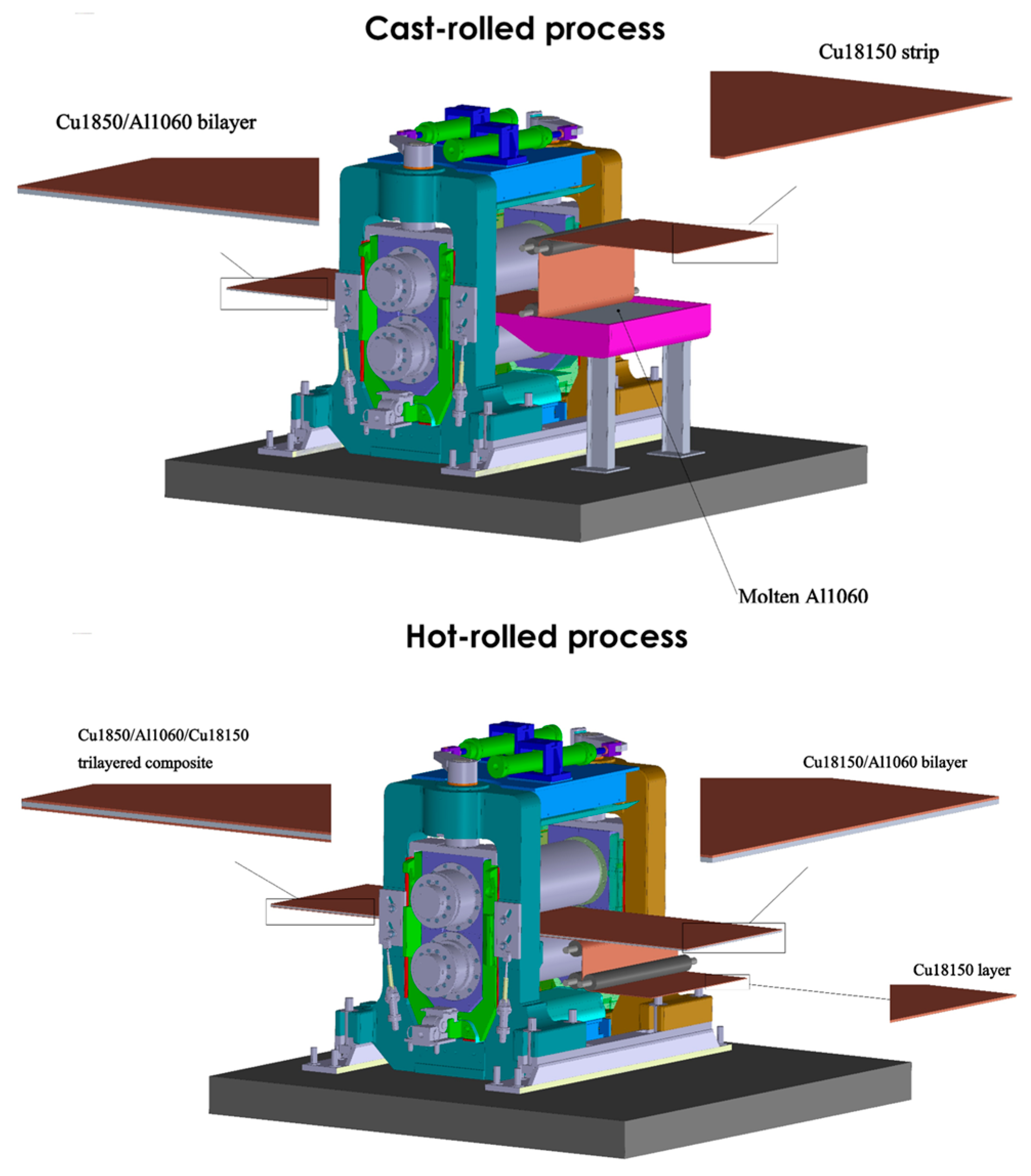


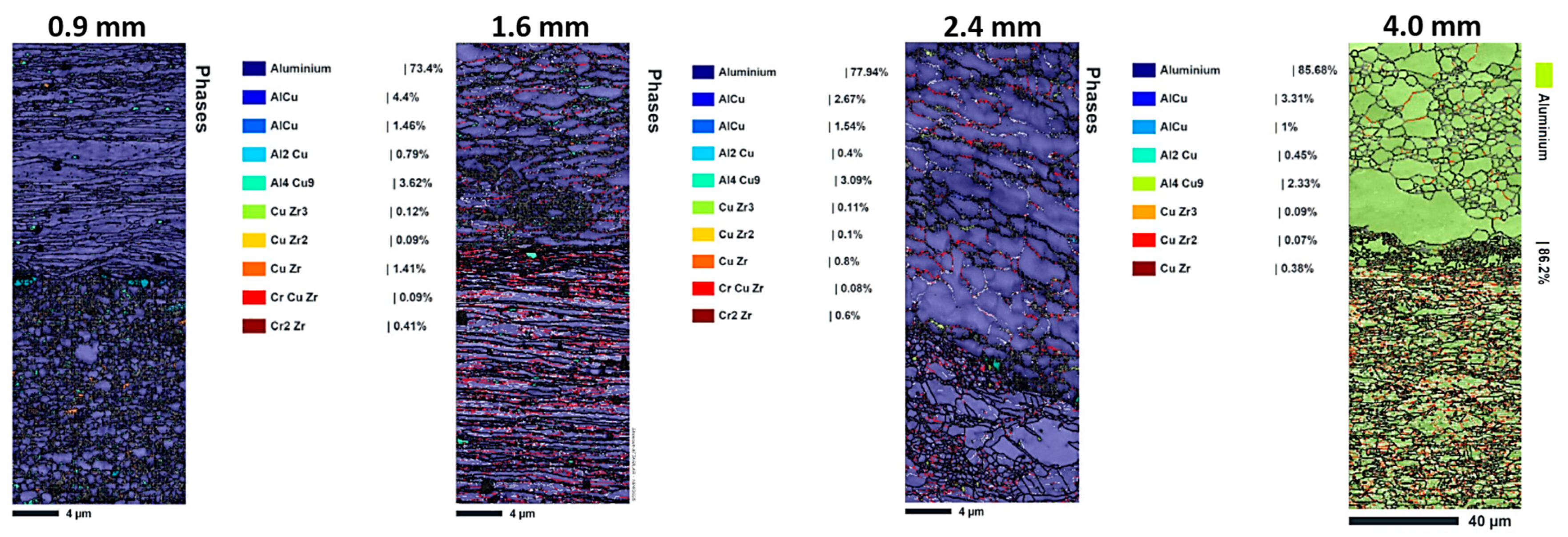
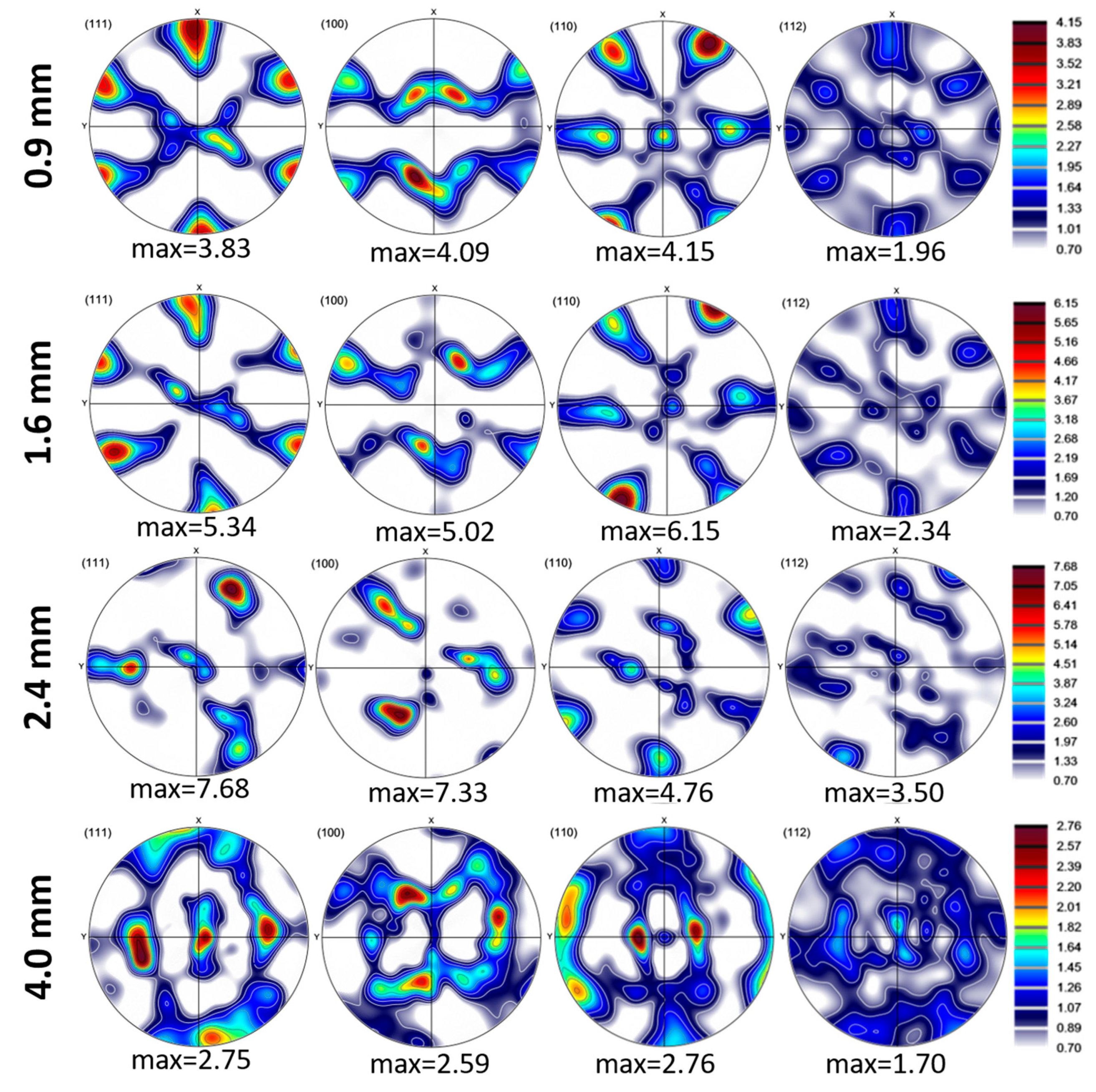

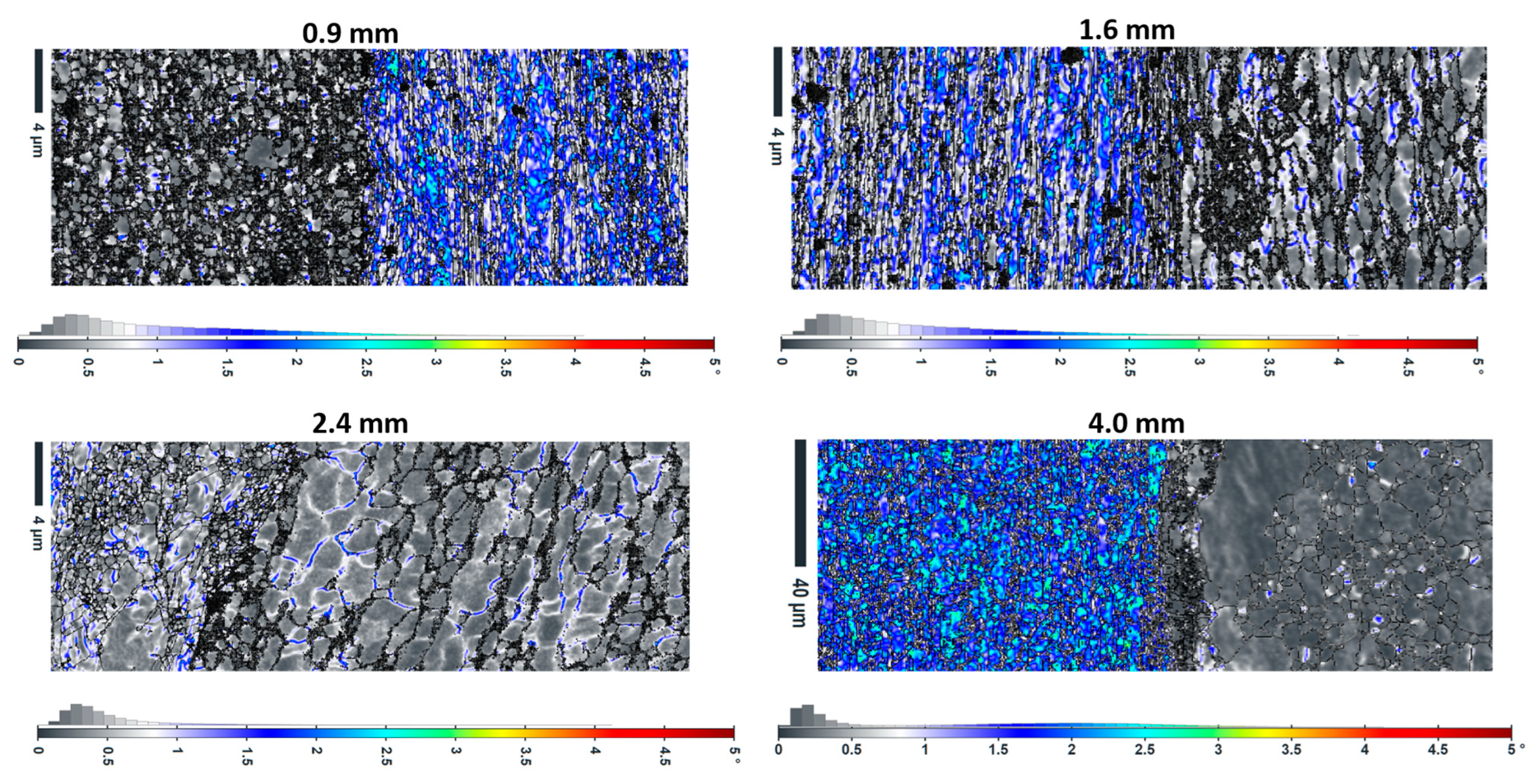

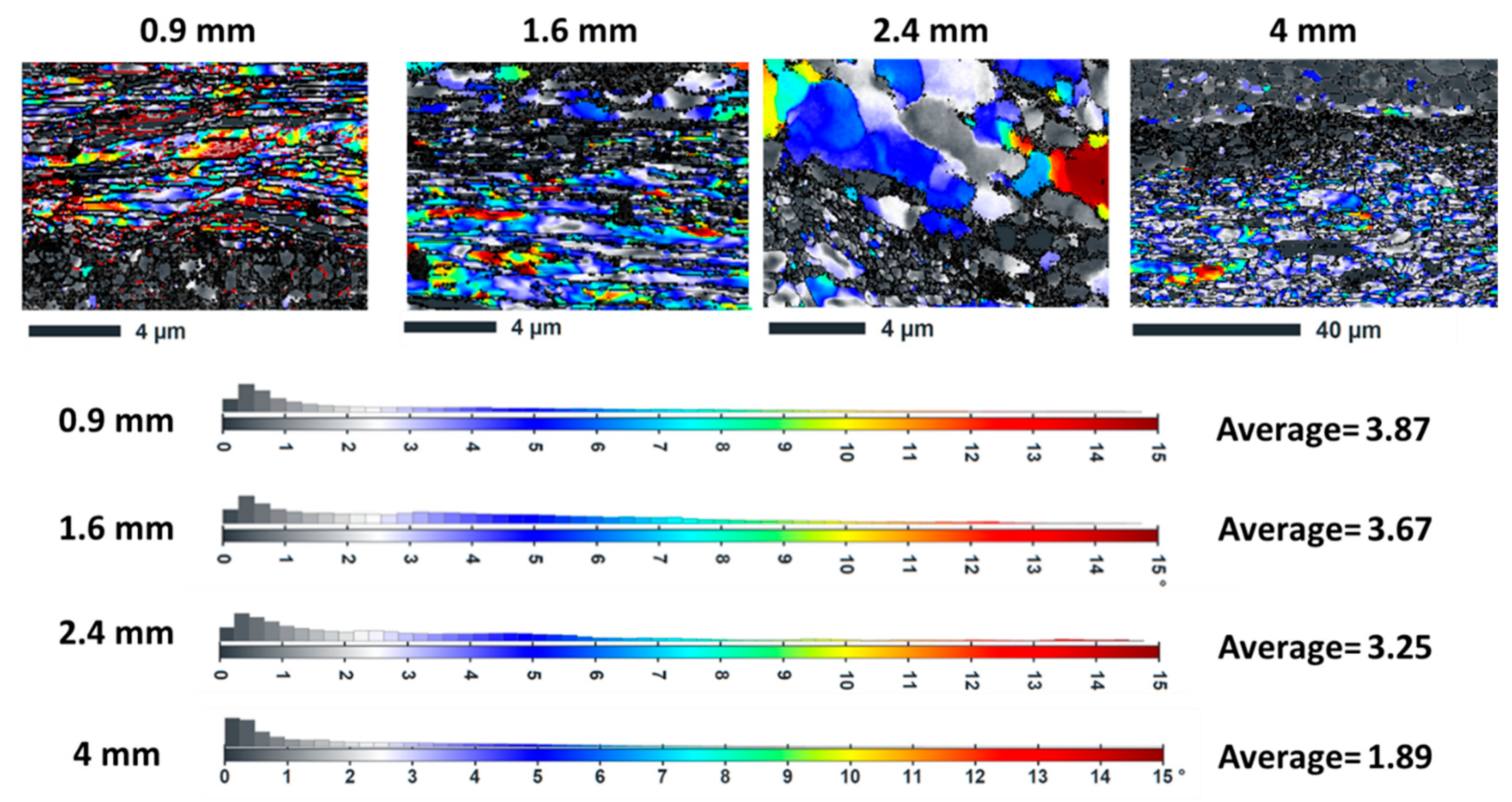
| Cu | Cr | Zr | Zn | Al | Fe | Si | Ni | Mn | Mg | |
|---|---|---|---|---|---|---|---|---|---|---|
| Cu18150 | 99.081 | 0.720 | 0.102 | 0.042 | 0.023 | - | 0.0079 | 0.015 | 0.0006 | 0.0004 |
| Al1060 | 0.050 | 0.0008 | - | 0.039 | 98.9 | 0.50 | 0.460 | 0.0037 | 0.0041 | 0.0033 |
| Thickness (mm) | Average Grain Size (µm) | Grain Size Standard Deviation (µm) |
|---|---|---|
| 0.9 | 1.23 | 1.33 |
| 1.6 | 1.73 | 1.29 |
| 2.4 | 4.49 | 3.86 |
| 4.0 | 6.08 | 7.24 |
| Sample Thickness (mm) | Phase Name | Approximate Composition (wt.%) |
|---|---|---|
| 0.9 | Aluminum (Al) | 77.40 |
| Intermetallic Al4Cu9 | 3.62 | |
| Intermetallic CuZr | 1.41 | |
| 1.6 | Aluminum (Al) | ~78–85 (within range of samples) |
| Intermetallics (AlCu, Al2Cu) | Present in small measurable amounts | |
| 2.4 | Aluminum (Al) | Over 80 |
| Intermetallics | More segregated distribution | |
| 4.0 | Aluminum (Al) | 86.2 (nearly pure aluminum) |
| Intermetallics | Minimal formation |
| Thickness (mm) | Average KAM (°) | KAM Standard Deviation | Maximum KAM (°) | Indexation Rate (%) |
|---|---|---|---|---|
| 0.9 | 0.28 | 0.03 | 3.46 | 85.79 |
| 1.6 | 0.48 | 0.51 | 3.64 | 87.00 |
| 2.4 | 0.48 | 0.39 | 4.15 | 93.31 |
| 4.0 | 0.63 | 0.73 | 3.61 | 86.00 |
| Thickness (mm) | Yield Strength (MPa) | Ultimate Tensile Strength (MPa) | Elongation (%) | Elastic Modulus (GPa) |
|---|---|---|---|---|
| 0.9 | 310 | 351 | 18 | 120 |
| 1.6 | 285 | 335 | 22 | 115 |
| 2.4 | 275 | 317 | 26 | 110 |
| 4.0 | 220 | 261 | 30 | 100 |
Disclaimer/Publisher’s Note: The statements, opinions and data contained in all publications are solely those of the individual author(s) and contributor(s) and not of MDPI and/or the editor(s). MDPI and/or the editor(s) disclaim responsibility for any injury to people or property resulting from any ideas, methods, instructions or products referred to in the content. |
© 2025 by the authors. Licensee MDPI, Basel, Switzerland. This article is an open access article distributed under the terms and conditions of the Creative Commons Attribution (CC BY) license (https://creativecommons.org/licenses/by/4.0/).
Share and Cite
Zhao, Y.; Ebrahimi, M.; Attarilar, S.; Lu, Q.; Jiang, H.; Wang, Q. Layer Thickness Effects on Residual Stress, Microstructure, and Tensile Properties of Cu18150/Al1060/Cu18150 Multilayered Composites: An Integrated EBSD-KAM Approach. Materials 2025, 18, 4673. https://doi.org/10.3390/ma18204673
Zhao Y, Ebrahimi M, Attarilar S, Lu Q, Jiang H, Wang Q. Layer Thickness Effects on Residual Stress, Microstructure, and Tensile Properties of Cu18150/Al1060/Cu18150 Multilayered Composites: An Integrated EBSD-KAM Approach. Materials. 2025; 18(20):4673. https://doi.org/10.3390/ma18204673
Chicago/Turabian StyleZhao, Yuchao, Mahmoud Ebrahimi, Shokouh Attarilar, Qiang Lu, Haiyan Jiang, and Qudong Wang. 2025. "Layer Thickness Effects on Residual Stress, Microstructure, and Tensile Properties of Cu18150/Al1060/Cu18150 Multilayered Composites: An Integrated EBSD-KAM Approach" Materials 18, no. 20: 4673. https://doi.org/10.3390/ma18204673
APA StyleZhao, Y., Ebrahimi, M., Attarilar, S., Lu, Q., Jiang, H., & Wang, Q. (2025). Layer Thickness Effects on Residual Stress, Microstructure, and Tensile Properties of Cu18150/Al1060/Cu18150 Multilayered Composites: An Integrated EBSD-KAM Approach. Materials, 18(20), 4673. https://doi.org/10.3390/ma18204673









